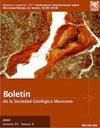墨西哥北部沙漠的岩石多样性和沙漠清漆的文化用途
IF 0.4
4区 地球科学
Q4 GEOLOGY
引用次数: 0
摘要
岩石清漆是一层薄薄的(每1000年1-40微米),颜色为深红色(30%的锰和铁氧化物,70%的粘土矿物),覆盖在墨西哥北部沙漠的岩石表面。这种吸积被祖先人类群体用作画布,记录墨西哥北部沙漠(索诺拉和奇瓦瓦)中不同类型的图案(动物化、几何化和拟人化)。这些岩画反映了过去居民的文化和艺术性质,清漆将他们保存了数千年。岩石清漆覆盖了各种类型的岩石,本文探讨了清漆与下伏岩石在化学成分和相互作用方面的差异。我们研究了三个不同地点的清漆:萨马拉尤卡(吉娃娃);ElÁlamo(索诺拉);和La Provedora(索诺拉)。显微镜、X射线衍射(XRD)和激光击穿光谱(LIBS)的分析技术揭示了类似的化学成分(主要是Mn、Fe、Ca和Al),它不取决于岩石多样性或位置(Samalayuca-砂岩-、ElÁlamo-砂岩-和La Provedora-花岗岩-)。我们观察到清漆和下层岩石之间的接触存在差异。清漆渗透到腐烂的矿物中,如斜长石;石英等坚硬矿物上可能会出现厚厚的堆积物。与之前的研究一样,我们发现底层材料对其清漆涂层的重要贡献很小,并得出结论,其主要成分主要来自风积沉积。本文章由计算机程序翻译,如有差异,请以英文原文为准。
Lithodiversity and cultural use of desert varnish in the Northern Desert of Mexico
Rock varnish is a thin layer (1-40 microns every 1000 years), dark-reddish in color (30% Mn and Fe oxides, 70% clay minerals), that coats a rock surfaces in the northern Mexican deserts. This accretion has been used as a canvas by ancestral human groups to record different types of motifs (zoomorphic, geometric and anthropomorphic) in the northern Mexican desert (Sonora and Chihuahua). These petroglyphs reflect the cultural and artistic nature of past inhabitants and the varnish preserves them through the millennia. Rock varnish coats a variety of rock types, and this paper explores differences in the chemical composition and interaction of varnish and the underlying rock. We studied varnish from three different sites: Samalayuca (Chihuahua); El Álamo (Sonora); and La Proveedora (Sonora). The analytical techniques of microscopy, X-Ray Diffraction (XRD) and Laser Breakdown Spectra (LIBS), reveals a similar chemical composition (Mn, Fe, Ca and Al mainly) that it does not depend on the lithodiversity or location (Samalayuca -sandstone-, El Álamo -sandstone- and La Proveedora -granite-). We observed differences in the contact between the varnish and the underlying rock. Varnish penetrate into decayed minerals such as plagioclase; thick accumulations can occur on hard minerals such as quartz. Like prior research, we find little important contribution of material from the underlying to its varnish coating and conclude its main component derives mostly from aeolian deposition.
求助全文
通过发布文献求助,成功后即可免费获取论文全文。
去求助
来源期刊
CiteScore
1.40
自引率
12.50%
发文量
34
审稿时长
50 weeks
期刊介绍:
The Boletín de la Sociedad Geológica Mexicana is a completely free-access electronic journal published semi-annually that publishes papers and technical notes with its main objective to contribute to an understanding of the geology of Mexico, of its neighbor areas, and of geologically similar areas anywhere on Earth’s crust. Geology has no boundaries so we may publish papers on any area of knowledge that is interesting to our readers.
We also favor the publication of papers on relatively unfamiliar subjects and objectives in mainstream journals, e.g., papers devoted to new methodologies or their improvement, and areas of knowledge that in the past had relatively little attention paid them in Mexican journals, such as urban geology, water management, environmental geology, and ore deposits, among others. Mexico is a land of volcanos, earthquakes, vast resources in minerals and petroleum, and a shortage of water. Consequently, these topics should certainly be of major interest to our readers, our Society, and society in general. Furthermore, the Boletín has been published since 1904; that makes it one of the oldest scientific journals currently active in Mexico and, most notably, its entire contents, from the first issue on, are available online.

 求助内容:
求助内容: 应助结果提醒方式:
应助结果提醒方式:


